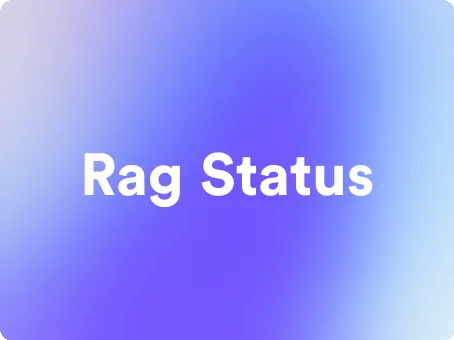Rag Status: A Comprehensive Guide to Project Tracking
This guide will walk you through the essential elements of using rag status - the productivity method to keep your team productive and engaged.
Try Lark for Free
In the realm of project management, RAG status serves as a valuable tool for tracking and communicating the status of various project elements. This article provides an in-depth exploration of RAG status, covering its origins, utility, best practices, and potential pitfalls.
What is Rag Status in the Context of Productivity?
RAG status, derived from the colors red, amber, and green, is a project management technique used to quickly and visually communicate the status of various aspects of a project. The color coding provides an intuitive and efficient means of conveying information about the progress and performance of project elements, allowing stakeholders to quickly grasp the current situation.
In the context of productivity, RAG status facilitates immediate understanding, enabling stakeholders to promptly identify areas that require attention. By assigning red, amber, or green statuses to specific project components, teams can easily gauge which aspects are on track, which ones need caution, and which demand immediate action.
Origin of Rag Status
The origin of RAG status can be traced back to the techniques used in traffic light signaling. The colors red, amber, and green have long been associated with signaling actions, with red signifying stop or caution, amber indicating a warning or potential slowdown, and green representing clearance or approval to proceed. This simple yet effective visual language has been adapted for use in various management contexts, including project tracking and progress reporting.
Use Lark to unleash your team productivity.
Who is Rag Status for?
RAG status is designed to benefit a wide array of stakeholders involved in project management, including project managers, team members, sponsors, and other entities with an interest in the project's progress. Its concise and intuitive nature makes it accessible to individuals at all levels of the organization, enabling quick assessment and informed decision-making.
Examples:
-
A project manager, utilizing RAG status, conducts a weekly project review meeting. During the meeting, the project manager presents the current status of each deliverable using RAG codes, allowing the team to collectively assess the project's overall health and address any potential issues that may hinder progress.
-
An executive overseeing multiple projects within a portfolio relies on RAG status reports to gain a high-level overview of project performance. This allows the executive to efficiently identify projects that require immediate attention or intervention, enabling proactive management of the portfolio.
-
A client receiving regular project updates benefits from the clarity provided by RAG status. The visual representation helps the client easily discern areas of progress and concern, fostering transparent and constructive communication with the project team.
What are the Pros and Cons of Rag Status?
Pros of Rag Status
- Clarity and Efficiency: RAG status provides a clear and intuitive means of understanding the status of multiple project elements at a glance, saving valuable time in communication and decision-making.
- Facilitates Quick Action: Immediate identification of problematic areas allows for timely intervention and corrective action, preventing potential project delays.
- Universal Understanding: The color-coded system is easily comprehensible to stakeholders across diverse roles and levels of expertise, fostering effective collaboration.
Cons of Rag Status
- Potential Oversimplification: In certain complex project scenarios, the simplicity of RAG status may lead to an oversimplification of problems, overlooking nuanced underlying issues.
- Risk of Misinterpretation: Without proper context and explanation, stakeholders may misinterpret the RAG statuses, leading to misguided assumptions and decisions.
Learn more about Lark x Productivity
How to Get Started with Rag Status
Implementing RAG status effectively requires a structured approach. The following steps outline the process of integrating RAG status into project management practices.
Step-by-Step Guide for Rag Status
Step 1: Identify Key Project Elements
- Begin by identifying the critical elements or deliverables within the project that warrant close tracking and reporting.
Step 2: Define Criteria for Evaluation
- Establish clear and measurable criteria for evaluating the status of each project element. This may include indicators such as timeline adherence, budget compliance, and quality benchmarks.
Step 3: Assign RAG Codes
- Based on the defined criteria, assign appropriate RAG codes (red, amber, or green) to signify the current status of each project element.
Step 4: Regular Reporting and Review
- Incorporate RAG status reporting into regular project meetings and update cycles to ensure ongoing visibility and assessment.
Step 5: Adjust and Act
- Leverage the insights gleaned from RAG status to make informed decisions and take corrective actions as necessary to maintain project trajectory.
Use Lark to unleash your team productivity.
Actionable Tips for Rag Status
RAG status can be maximized for effectiveness through the following actionable tips:
- Consistent Criteria: Ensure consistency and clarity in the criteria used to assign RAG statuses, minimizing ambiguity and misinterpretation.
- Timely Updates: Maintain regular and timely updates of RAG statuses to reflect the current and evolving project landscape.
- Transparent Communication: Provide context and explanations alongside RAG status reports to ensure stakeholders possess the necessary understanding of the underlying factors contributing to each status.
Do's and Dont's
The following table delineates the essential do's and don'ts when utilizing RAG status in project management:
| Do's | Dont's |
|---|---|
| Use RAG status to prompt discussions and action points | Rely solely on RAG status without additional context or explanation |
| Align RAG codes with predefined criteria | Utilize RAG status as the sole indicator of project health |
| Regularly review and update RAG statuses | Overcomplicate the RAG status system with excessive criteria |
Conclusion
RAG status stands as a valuable ally in the realm of project management, offering a succinct yet powerful method of tracking and communicating project status. By harnessing the RAG framework effectively, project teams and stakeholders can enhance their ability to swiftly identify and address critical aspects that impact project success.
